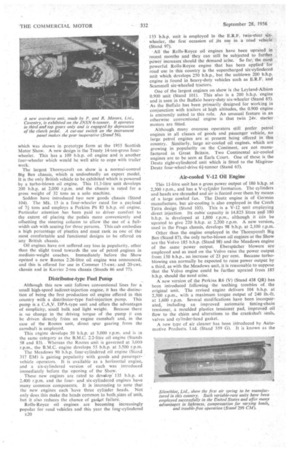Distributor - type Fuel Pinup
Page 86

If you've noticed an error in this article please click here to report it so we can fix it.
Although this new unit follows conventional lines for a small high-speed indirect-injection engine, it has the distinction of being the first production oil engine offered in this country with a distributor-type fuel-injection pump. This pump is a C.A.V. DPA-type unit and offers the advantages of simplicity, small bulk and light weight. Because there is no change in the driving torque of the pump it can be driven directly from an engine camshaft and, in the case of the Rootes unit, direct spur gearing from the camshaft is employed.
This engine develops 50 b.h.p. at 3,000 r.p.m. and is in the same category as the B.M.C. 2.2-litre oil engine (Stands .58 and 83). Whereas the Rootes unit is governed at 3,000 r.p.m., the B.M.C. engine develops 55 b.h.p. at 3.500 r.p.m.
The Meadows 90 b.h.p. four-cylindered oil engine (Stand 317 EM) is gaining popularity with goods and passengervehicle operators. It is available as a horizontal engine, and a six-cylindered version of each was introduced immediately before the opening of the Show.
These new engines are rated to develop' 135 b.h.p. at 2,400 r.p.m. and the fourand six-cylinderecl engines have many common components, It is interesting to note that the new engines each have three cylinder heads. Not only does this make the heads common to both,sizes of unit, but it also reduces the chance of gasI4et failure.
Rolls-Royce oil engines are becoming increasingly popular for road vehicles and this year the fotti-cylindered e20
133 b.h.p. unit is employed in the E.R.F. twin-steer Sixwheeler, the first occasion of its use in a road vehicle (Stand 97).
All the Rolls-Royce oil engines have been uprated in recent months and they can still be subjected to further power increases should the demand arise. So far, the most powerful Rolls-Royce engine that has been applied for road use in this country is the supercharged six-cylindered unit which develops 250 b.h.p., but the unblown 200 b.h.p. engine is found in heavy-duty vehicles such as E.R.F. and Scammell six-wheeled tractors.
One of the largest engines on show is the Leyland-Albion 0.900 unit (Stand 101). This also is a 200 b.h.p. engine and is seen in the Buffalo heavy-duty six-wheeler (Stand 85). As the Buffalo has been primarily designed for working in conjunction with trailers at high altitudes, the 0.900 engine is eminently suited to this role. An unusual feature in an otherwise conventional engine is that twin 24v. starter motors are fitted.
Although many overseas operators still prefer petrol engines in all classes of goods and passenger vehicle, no large petrol engines are at .present being Offered in this country. Similarly, large air-cooled oil engines, which are growing in popularity on the Continent, are not manufactured in Great Britain. Two Continental air-cooled engines are to be seen at Earls Court. One of these is the Deutz eight-cylindered unit which is fitted to the MagirusDeutz four-wheel-drive 61-tonner (Stand 65).




































































































































































